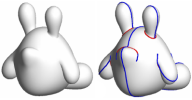CS 523 Computer Graphics, Spring 2011
Register for this class as 198:523.



This class is about digital geometry processing and interactive shape modeling
Digital 3D content creation is in high demand in the film and gaming industries, product design and manufacturing, architecture, surgical simulation and planning, medical prosthesis design and more, and it is backed up by affordable 3D acquisition technologies. Yet, shape modeling tasks, such as creation, editing, deformation and animation, remain extremely laborious, requiring artistic skills and high technical expertise. This course will survey state-of-the-art shape modeling research that aims at broadening our knowledge and understanding of shapes to create better digital modeling tools, and explores ways to communicate the human intentions of shape manipulation to the computer in a natural and effective manner. The course will begin by covering some introductory topics in geometric modeling, with an emphasis on discrete geometry processing: digital shape representations and related data structures, shape acquisition and reconstruction, smoothing and denoising, parameterization, remeshing. The course will then concentrate on recent shape creation and manipulation research, touching on variational modeling techniques, space deformations, sketch-based modeling interfaces, shape interpolation and skeleton-skin animation of articulated bodies. The necessary mathematical tools will be presented along the way (these include topics in linear algebra, differential geometry and optimization).
Expected work
Students will design, implement, and use interactive graphical applications. The course is currently taught using C/C++, OpenGL and various Linear Algebra libraries.
This amounts to three programming projects, two short (written) homework assignments covering mathematical concepts, and one paper presentation. On the third and final programming project, a significant extension (of the student's choice) must be completed, including a written project report and a presentation. For more details on the course schedule, see the syllabus.
Prerequisites
It is advantageous to have experience from an introductory computer graphics course (such as CS 428), but the necessary subset of real time rendering using OpenGL can also be obtained on the fly. Other than that, I will assume that participants are familiar with basic calculus, linear algebra, and vector calculus.